World number 135 and qualifier Fabian Marozsan defeated Carlos Alcaraz 6/3 7/6 in the third round of the Rome Masters 1000 on Monday with a flurry of forehands and drop shots.
I mean, no one saw this coming. Yes, he beat Lehecka in the prior round—a guy who is also having a breakout year—but by the odds this is one of the biggest upsets in the game in recent memory, as Nishikori, Tennis Pro bettor outlines below.
And if you want a concise analysis of this match regarding the use of the drop shot, Matt Willis’ Twitter thread is superb and touches on similar tropes that I made in the Barcelona final analysis between Alcaraz and Tsitsipas.
A Forehand is Born Reborn
The Maroszan drop shot was superb today. He won his first six attempts and went 10/13 on points when he used that shot. In contrast, Alcaraz only managed 4/7, which is still respectable, but respectable hasn’t really been the word used to describe the Alcaraz drop-shot form in recent months. It’s usually been ridiculous/genius/etc. However, just like Alcaraz, behind every great drop shot is a great forehand, and I love the Marozsan forehand.
From a technical standpoint, Marozsan is another data point to add to the general forehand thesis of this newsletter: extended wrist, gravity-assisted mechanics.
This setup is not unlike another bloke who had a decent Babolat-infused hammer1:


And today the young Hungarian just hammered away fearlessly from the first point to the last. He then weaved ridiculous drop shots into this style. That’s one way to beat Alcaraz. In the last post after the Madrid final, I said of Struff:
“Struff played a tactically smart match today. He knew he didn’t have the movement or rally edge, and he committed to a strategy that gave him the best chance of winning. It also meant he forced Alcaraz into a mode of play he isn’t used to; Alcaraz didn’t venture forward too much or get an opportunity to play many drop shots.”
But, I also said:
“Ultimately, while this was a high-risk brand of tennis that neutralized the best defender in the game, there are few players (and to an extent, conditions) that are capable of pulling this brand of tennis off this well. Struff has a big serve, is an accomplished net player with a strong doubles resume, and was absolutely lasering his groundstrokes and returns for the better part of 90 minutes. I can’t think of too many other players who could get in this mindset, let alone execute this type of tennis (Rune, Tiafoe, Kyrgios, and Bublik come to mind).”
I eat my words. And add Marozsan to the top of that list.
What stood out to me from Marozsan was how good his inside-in forehand was; an unreal combo of power and control.
He just crushed it into the Alcaraz forehand and rushed the Spaniard.
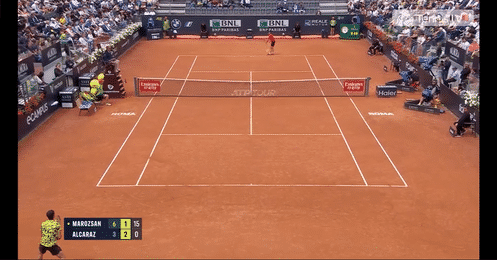
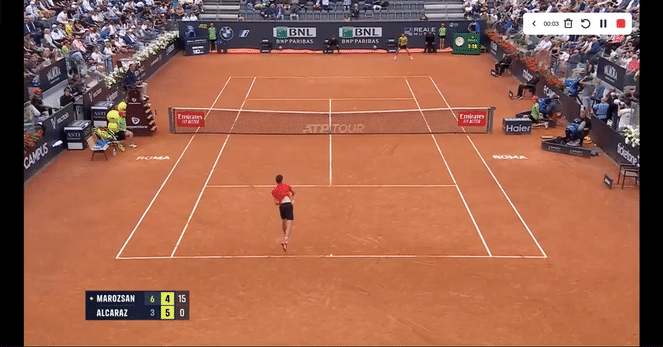
It’s Gonzo tennis below:
Official title of the below shot: “Fall away inside-in reverse-finish forehand winner”.
Paired with a very solid backhand, the 6’4’’ Marozsan was able to take the ball on the rise and play a flat and hard brand of tennis. It completely wrecked Alcaraz’s usual playstyle where he has time and forecourt space to find off forehands and dictate rally details with his usual variation, hence the paltry 7 drop shot attempts—only 4 from his forehand.


He made uncharacteristically poor decisions at times as well compared to his usual excellence.

Similar to Struff, Marozsan took on a very aggressive return position in a bid to rush Alcaraz, even on first serves:

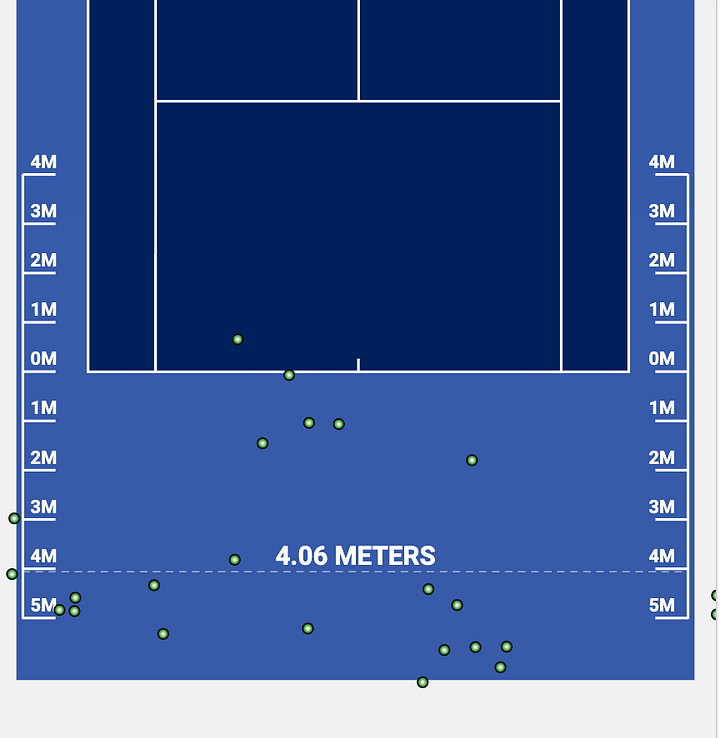
I wonder if Alcaraz needs to employ a higher, loopier return of serve in the vein of Musetti and Nadal when facing a player who is using a mixed strategy of huge power combined with drop shots. The higher return would buy him more time to recover, as well as make the drop shot a harder choice for Marozsan, Struff, and Co., who are trying to unsettle him with such a tactic. I think mixing that in and going into a lockdown mode that has been so successful by Nadal and Djokovic, where they use their legs and end-range athleticism to absorb the storm of an aggressive opponent, would warrant attention. It’s not quite Alcaraz’s nature, after all, he loves to attack and self-describes his game like Federer, but I think he has the ability to add that to his game.
And as for Marozsan, is a star born? I have no idea and the data set is still too small. I like the forehand, I like the composure. In saying that, Alcaraz didn’t play very well and I can’t see Marozsan playing the drop shot that well consistently; some of them were just outrageous. I do think he’s a top-20 prospect in the next few years, but who knows? A look at the rap sheet:
By my metrics:

The bottom half is really open now in Rome. I’ll be back after the final with more thoughts.
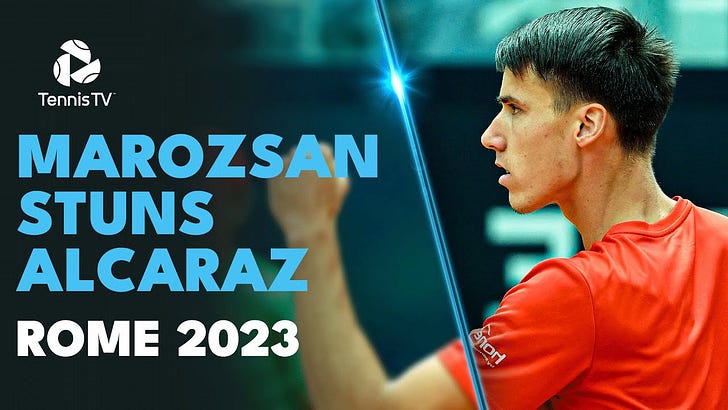


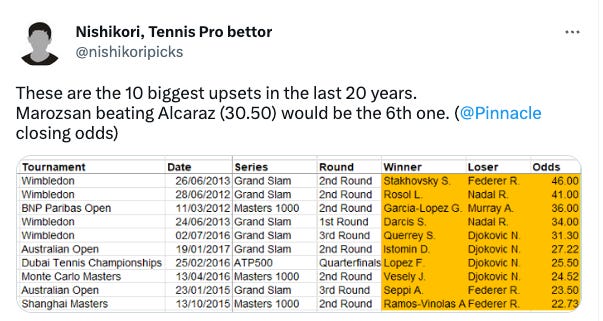

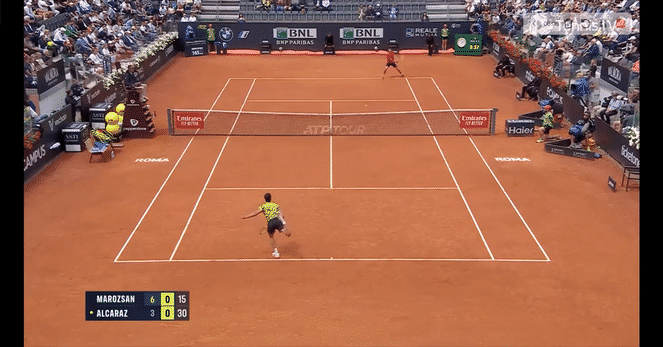



It's getting to the point - and I know that opinion might go down as one the worst of the 21st century in no time - where I think the Marozsan / Struff / Sinner / Ruusuvuori match-up (so taking time away and being in full agression MO - might be worse for Carlos than someone like Djokovic (that's why it's controversial). Not even for technical reasons (even though carlos's backhand is likely to "break" faster/easier than nole's for reasons you mentioned earlier - no drop and inside prep) because for example Novak's worst GS match-up is Stan, famous ball butcher (with incredible fundamentals) but in the sense that I always felt, watching Novak, that he gave you a sense of rythm, like you kinda know what happens next. Which doesnt make him easier to beat because he is gonna break you down (just like he did with every next gen player with at least one technical flaw) but maybe just maybe Alcaraz (and also rune and maybe sinner soon), with their raw athleticism and great technique, can break that curse and take that rythm to their advantage over 5 sets.
Obviously a prediction but I'm very excited for the french. Physically speaking, losing early in Rome might be best for Carlos's condition.
Would be interesting to hear your analysis on the Djokovic - Rune game. Novak clearly wasn’t himself. But what was it? Fatigue? Nerves? Either way, Rune capitalized.